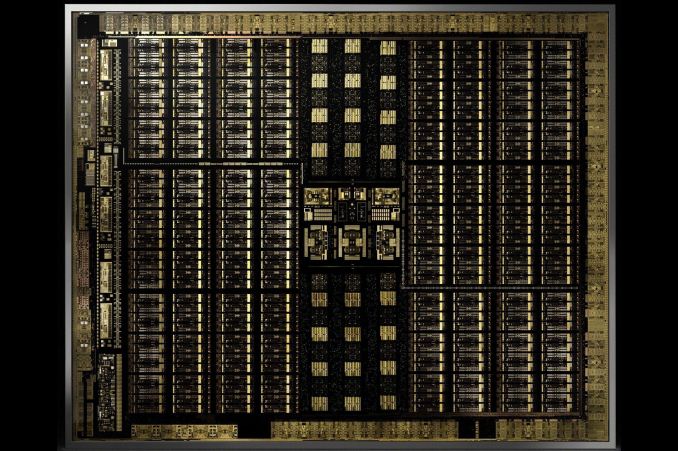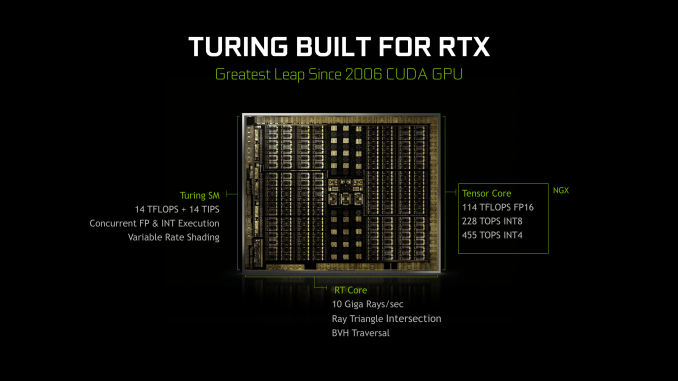The NVIDIA Turing GPU Architecture Deep Dive: Prelude to GeForce RTX
by Nate Oh on September 14, 2018 12:30 PM EST
It’s been roughly a month since NVIDIA's Turing architecture was revealed, and if the GeForce RTX 20-series announcement a few weeks ago has clued us in on anything, is that real time raytracing was important enough for NVIDIA to drop “GeForce GTX” for “GeForce RTX” and completely change the tenor of how they talk about gaming video cards. Since then, it’s become clear that Turing and the GeForce RTX 20-series have a lot of moving parts: RT Cores, real time raytracing, Tensor Cores, AI features (i.e. DLSS), raytracing APIs. All of it coming together for a future direction of both game development and GeForce cards.
In a significant departure from past launches, NVIDIA has broken up the embargos around the unveiling of their latest cards into two parts: architecture and performance. For the first part, today NVIDIA has finally lifted the veil on much of the Turing architecture details, and there are many. So many that there are some interesting aspects that have yet to be explained, and some that we’ll need to dig into alongside objective data. But it also gives us an opportunity to pick apart the namesake of GeForce RTX: raytracing.
While we can't discuss real-world performance until next week, for real time ray tracing it is almost a moot point. In short, there's no software to use with it right now. Accessing Turing's ray tracing features requires using the DirectX Raytracing (DXR) API, NVIDIA's OptiX engine, or the unreleased Vulkan ray tracing extensions. For use in video games, it essentially narrows down to just DXR, which has yet to be released to end-users.
The timing, however, is better than it seems. A year or so later could mean facing products that are competitive in traditional rasterization. And given NVIDIA's traditionally strong ecosystem with developers and middleware (e.g. GameWorks), they would want to leverage high-profile games for ringing up consumer support for hybrid rendering, which is where both ray tracing and rasterization is used.
So as we've said before, with hybrid rendering, NVIDIA is gunning for nothing less than a complete paradigm shift in consumer graphics and gaming GPUs. And insofar as real time ray tracing is the 'holy grail' of computer graphics, NVIDIA has plenty of other potential motivations beyond graphical purism. Like all high-performance silicon design firms, NVIDIA is feeling the pressure of the slow death of Moore's Law, of which fixed function but versatile hardware provides a solution. And where NVIDIA compares the Turing 20-series to the Pascal 10-series, Turing has much more in common with Volta, being in the same generational compute family (sm_75 and sm_70), an interesting development as both NVIDIA and AMD have stated that GPU architecture will soon diverge into separate designs for gaming and compute. Not to mention that making a new standard out of hybrid rendering would hamper competitors from either catching up or joining the market.
But real time ray tracing being what it is, it was always a matter of time before it became feasible, either through NVIDIA or another company. DXR, for its part, doesn't specify the implementations for running its hardware accelerated layer. What adds to the complexity is the branding and marketing of the Turing-related GeForce RTX ecosystem, as well as the inclusion of Tensor Core accelerated features that are not inherently part of hybrid rendering, but is part of a GPU architecture that has now made its way to consumer GeForce.
For the time being though, the GeForce RTX cards are not released yet, and we can’t talk about any real-world data. Nevertheless, the context of hybrid rendering and real time ray tracing is central to Turing and to GeForce RTX, and it will remain so as DXR is eventually released and consumer-relevant testing methodology is established for it. In light of these factors, as well as Turing information we’ve yet to fully analyze, today we’ll focus on the Turing architecture and how it relates to real-time raytracing. And be sure to stay tuned for the performance review next week!












111 Comments
View All Comments
Tamz_msc - Saturday, September 15, 2018 - link
"Besides, what you said isn't true even limiting the discussion to what was covered in this article. The Turing Tensor cores allow for a greater range of precisions."You mean lower precision, right? INT8 and INT4 are lower range. From a higher-level view Volta is very similar to Turing, just like the OP described.
Yojimbo - Saturday, September 15, 2018 - link
"greater range of precisions"INT8, INT4, FP16, etc., are precisions. The range of precisions an architecture can handle is the set of all precisions it can handle. Turing Tensor Cores can handle INT4, INT8, and FP16, whereas Volta Tensor Cores can handle FP16. So Turing can handle a greater range of precisions.
Bulat Ziganshin - Friday, September 14, 2018 - link
I would pray for 2060 w/o all this RT/FP16 stuffSpunjji - Monday, September 17, 2018 - link
Seems likely given how nutso these die sizes are. I expect we won't see it until after Pascal inventory is cleared, though.Da W - Friday, September 14, 2018 - link
Well still playing on my 3-screen Haswell + GTX780 rig, and being pretty satisfied of it, i'll probably just get a cheap GTX 1070 or 1080 for my new Ryzen rig and wait if ray tracing really gets adopted in 1 or 2 years. Seems to me lots of transistors invested for not many games. If history told us anything, it's not because a technology is great that it will get adopted, especially if it asks LOADS more developper time for the game companies.Not sure AMD won't come up with something either down the line. They've been given for dead for over 2 decades, guess where they are now!
Holliday75 - Monday, September 17, 2018 - link
I am waiting as well. This is the first attempt to change the game. Next gen or two is where it will be fined tuned and worth purchasing. This feels like a 4k TV purchase. Waste of money.abufrejoval - Friday, September 14, 2018 - link
I wonder how much Turing is about staking out territorial claims vs. dark silicon also coming to GPUs...Obviously Nvidia wants to protect its CUDA machine learning and HPC empire against custom ASIC competitors which finally also include Intel with their Configurable Spatial Accellerator, as well as Cambricon, Google's TPU ASICs and far too many others for comfort.
But while many seem to bemoan that tensor core or rasterizing real-estate is a waste for gaming and just about raising the purchase prices with overhyped features nobody needs, I wonder if apart from the partial truth in that the other motivating driver is simply that the inability to translate additional transistors into additional performance as additional bandwidth requires step changes in GDDR6 lanes (with unshrinkable pad areas and amplifiers) and hits foundry reticle sizes.
So they had transistors left over (wonder where those came from without a die shrink: I/O voltage reduction, layout optimizations, really bigger chips?), that could not be turned into direct DX1x performance gains due to bandwidth and TDP constraints and going to a richer functional base with Tensor Cores and raytrace assists would eat alternate bandwidth or TDP budgets, not additional ones.
Any truth in those assumptions?
abufrejoval - Friday, September 14, 2018 - link
ok, much bigger chips...And no rip-off: They are worth what they are charging if only for the inference accelleration.
Yojimbo - Saturday, September 15, 2018 - link
I am not convinced the Tensor Cores take up a lot of real estate. And they are tightly integrated into NVIDIA's SMs. Designing two SMs, one with Tensor Cores and one without Tensor Cores would be a lot more expensive than leaving them in. Plus, NVIDIA sees deep learning as important for gaming.Your argument about FLOPS per bandwidth does have validity. It's just that neither Tensor Cores nor RT cores were just thrown in there because they had transistors left over. Look at the die sizes of these new GPUs compared to Pascal GPUs. If they built a smaller chip that performed the same in legacy games then they could sell them more cheaply, and so sell more of them, while making the same profit on each one. That would mean higher margins and greater profits.
The RTX and Tensor Cores are a strategic initiative. I think in making the decision to include them NVIDIA judged that those two technologies would have a positive impact on the future of gaming. The reason they made that judgment may include the dwindling FLOPS/memory bandwidth trend.
bernstein - Friday, September 14, 2018 - link
really interesting time in gpu's right now... remember a decade ago when intel teased a x86-gpu that promised to do real-time raytracing?yet turing may turn out to provide an abysmal price/perf ratio.
- about half the transistors will only be used in a few upcoming games, they could be used to possibly double performance in rasterization-only games (7nm amd navi anyone?)
- but if (hybrid-)raytracing takes off quickly, turing will be crushed by 7nm gpu's dedicating way more transistors to the task, as it's performance is still skewed heavily towards rasterization
- ai inferencing seems like a safe bet, again i'd wager that DLSS will only ever work with the vast minority of games released each day on steam, so it's usefulness will depends on whether developers make other use of the available silicon... (better AI opponents anyone?)